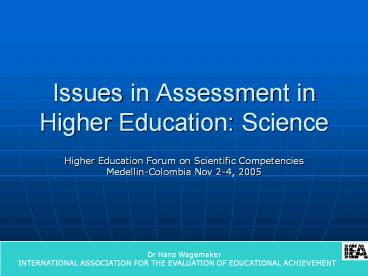Issues in Assessment in Higher Education: Science PowerPoint PPT Presentation
1 / 27
Title: Issues in Assessment in Higher Education: Science
1
Issues in Assessment in Higher Education Science
- Higher Education Forum on Scientific Competencies
- Medellin-Colombia Nov 2-4, 2005
Dr Hans Wagemaker INTERNATIONAL ASSOCIATION FOR
THE EVALUATION OF EDUCATIONAL ACHIEVEMENT
2
Theme Validity in Assessment
- What can/should be Assessed.
- How can it be Assessed
- Frameworks, Curriculum and Trajectories
- From TIMSS to Higher Education
3
Purpose of Assessment Assessment for
Learning/Assessment of Learning
- Validity/Reliability- Primacy of Validity
- Construct Validity
- Consequential Validity
4
TIMSS what is AssessedContent Domains
- Grade 4 Life, Physical and Earth Science
- Grade 8- Biology, Chemistry, Physics, Earth
ScienceTIMSS Design
5
What is Assessed Cognitive Assessment Domains
- Knowing
- Applying
- Reasoning
- Scientific Inquiry
- Implies different strategies
6
Knowing
- 1. Recall/Recognize- statements, facts,
relationships, processes, concepts. - 2. Define- provide or identify definitions of
scientific terms, vocabulary, symbols,
abbreviations, units, scales in appropriate
contexts. - 3. Describe- organisms, physical materials,
scientific processes that demonstrate knowledge
of properties, structure and relationships.
7
Knowing
- 4. Illustrate with Examples support or clarify
statements of facts or concepts with appropriate
examples- provide specific examples - 5. Use tools and procedures demonstrate
knowledge of the use of science apparatus,
equipment , tools, procedures, measurement
devices.
8
Applying
- 1. Compare contrast classify- identify or
describe similarities/differences between groups
of organisms, materials, processes distinguish,
classify or order objects, materials or organisms
and processes based on given characteristics and
properties.
9
Applying
- 2. Use Models use a diagram or model to
demonstrate science concept, structure,
relationship, process, biological or physical
system or cycle ( e.g.. Atomic structure,
electrical circuit, water cycle)
10
Applying
- 3. Relate relate knowledge of an underlying
biological or physical concept to an observed or
inferred property, behavior, or use of objects,
organisms or materials - 4. Interpret information - interpret textual,
tabular or graphical information in light of a
scientific concept or principle
11
Applying
- 5. Find solutions use a science relationship,
equation, or formula to find a qualitative or
quantitative solution involving the direct
application/demonstration of a concept - 6. provide and explanation for an observation
demonstrating understanding of the underlying
science concept, principle, law or theory.
12
Reasoning
- 1. Analyze problems to determine the relevant
relationships, concepts and problem solving steps
develop problem solving strategies - 2. Integrate/Synthesize provide solutions to
problems that require consideration of a number
of different factors or related concepts
integrate mathematical concepts
13
Reasoning
- 3. Hypothesize/predict combine science
knowledge with information from
observation/experience or formulate questions
that can be answered by investigation formulate
testable hypotheses make predictions about
effects of changes in biological or physical
conditions in light of evidence and scientific
understanding
14
Reasoning
- 4. Design Plan investigations appropriate for
answering questions - 5. Draw conclusions detect patterns in data
trends interpolate - 6. Generalize make general conclusions that go
beyond experimental or given conditions - 7. Evaluate weigh advantages/disadvantages
about alternative processes, materials,
alternative explanations etc.
15
Reasoning
- Justify use evidence and scientific
understanding to justify explanations and problem
solutions
16
Scientific Inquiry
- 1. Demonstrate a formalized approach to
scientific investigation
17
Core Principles of Effective Assessment
- 1. assessment that guides and encourages to
effective approaches to learning - 2. assessment that validly and reliably measures
expected learning outcomes, in particular
higher-order learning that characterizes higher
education - 3. assessment and grading that defines and
protects academic standards
18
Assessment for Learning- Formative
- Validity of Assessment for learning is high when
assessment procedures help the student toward
achieving the real goals of the learning
activity - Requires, committed participants, trust,
understanding of what is being asked, effective
feedback
19
Assessment for Learning Formative Assessment
- Task Factors Knowledge of key aspects and
difficulties of task - Criteria students told ( and understand)
clearly what is needed. - Standards set standards are appropriate to
students - Feedback balance of attention both strengths
and weaknesses- is useful for student
20
Assessment of Learning Summative Assessment
- Done under conditions that give confidence it is
students own work. - Marking is standardized across several of many
teachers - Most up to date information possible
21
Assessment of learningSummative Assessment
- Quality ( and appropriateness) should take
precedence over quantity - Things that can be assessed in final exam should
be - those that can not should not. - If multiple assessments of same material final
grade should reflect final level of performance
22
Assessment of Learning- Summative Assessment
- Disadvantage time sampling problem
- May not be valid for admitting student to next
stage of education
23
Indicators of affective assessments
- 1. assessment which is integral component of
teaching and learning process - 2. multiple roles of assessment recognized.
- 3. departmental/faculty policy as guide
- 4. alignment between what is taught and what is
assessed.
24
Indicators..
- 5. Assessment tasks assess capacity to analyze
and synthesize new information. - 6. Variety of assessments used
- 7. Assessment designed to assess generic skills
as well as subject specific skills
25
Indicators
- 8. steady progression of complexity and demands
in later years - 9. student choice (paper/exam/timing)
- 10. workloads considered
- 11. not excessive assessment
- 12. task weighted to balance formative and
summative roles
26
Indicators
- 13. Grades calculated on basis of clearly
articulated learning outcomes. - 14. Students provided with explanatory feedback
- 15. Tasks checked for bias
- 16. Plagiarism minimized
27
Assessment formats
- Multiple choice
- Extended Response
- Individual Project
- Thesis
- Laboratory work
- Group work
- Computer based
- Presentations
- Many others oral, portfolio

